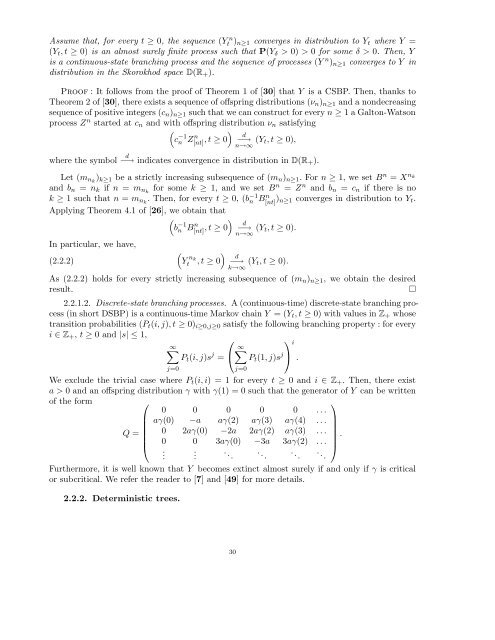arbres aléatoires, conditionnement et cartes planaires - DMA - Ens
arbres aléatoires, conditionnement et cartes planaires - DMA - Ens
arbres aléatoires, conditionnement et cartes planaires - DMA - Ens
You also want an ePaper? Increase the reach of your titles
YUMPU automatically turns print PDFs into web optimized ePapers that Google loves.
Assume that, for every t ≥ 0, the sequence (Y n<br />
t ) n≥1 converges in distribution to Y t where Y =<br />
(Y t ,t ≥ 0) is an almost surely finite process such that P(Y δ > 0) > 0 for some δ > 0. Then, Y<br />
is a continuous-state branching process and the sequence of processes (Y n ) n≥1 converges to Y in<br />
distribution in the Skorokhod space D(R + ).<br />
Proof : It follows from the proof of Theorem 1 of [30] that Y is a CSBP. Then, thanks to<br />
Theorem 2 of [30], there exists a sequence of offspring distributions (ν n ) n≥1 and a nondecreasing<br />
sequence of positive integers (c n ) n≥1 such that we can construct for every n ≥ 1 a Galton-Watson<br />
process Z n started at c n and with offspring distribution ν n satisfying<br />
where the symbol<br />
(<br />
c −1<br />
n Zn [nt] ,t ≥ 0 )<br />
d<br />
−→<br />
n→∞ (Y t,t ≥ 0),<br />
d<br />
−→ indicates convergence in distribution in D(R + ).<br />
L<strong>et</strong> (m nk ) k≥1 be a strictly increasing subsequence of (m n ) n≥1 . For n ≥ 1, we s<strong>et</strong> B n = X n k<br />
and b n = n k if n = m nk for some k ≥ 1, and we s<strong>et</strong> B n = Z n and b n = c n if there is no<br />
k ≥ 1 such that n = m nk . Then, for every t ≥ 0, (b −1<br />
n Bn [nt] ) n≥1 converges in distribution to Y t .<br />
Applying Theorem 4.1 of [26], we obtain that<br />
( )<br />
b −1<br />
n Bn [nt] ,t ≥ 0 d<br />
−→ (Y t,t ≥ 0).<br />
n→∞<br />
In particular, we have,<br />
( )<br />
(2.2.2)<br />
Y n k d<br />
t ,t ≥ 0 −→ (Y t,t ≥ 0).<br />
k→∞<br />
As (2.2.2) holds for every strictly increasing subsequence of (m n ) n≥1 , we obtain the desired<br />
result.<br />
□<br />
2.2.1.2. Discr<strong>et</strong>e-state branching processes. A (continuous-time) discr<strong>et</strong>e-state branching process<br />
(in short DSBP) is a continuous-time Markov chain Y = (Y t ,t ≥ 0) with values in Z + whose<br />
transition probabilities (P t (i,j),t ≥ 0) i≥0,j≥0 satisfy the following branching property : for every<br />
i ∈ Z + , t ≥ 0 and |s| ≤ 1,<br />
⎛ ⎞i<br />
∞∑<br />
∞∑<br />
P t (i,j)s j = ⎝ P t (1,j)s j ⎠ .<br />
j=0<br />
We exclude the trivial case where P t (i,i) = 1 for every t ≥ 0 and i ∈ Z + . Then, there exist<br />
a > 0 and an offspring distribution γ with γ(1) = 0 such that the generator of Y can be written<br />
of the form ⎛<br />
⎞<br />
0 0 0 0 0 ...<br />
aγ(0) −a aγ(2) aγ(3) aγ(4) ...<br />
Q =<br />
0 2aγ(0) −2a 2aγ(2) aγ(3) ...<br />
.<br />
⎜<br />
⎝ 0 0 3aγ(0) −3a 3aγ(2) ... ⎟<br />
⎠<br />
.<br />
. . .. . .. . .. . ..<br />
Furthermore, it is well known that Y becomes extinct almost surely if and only if γ is critical<br />
or subcritical. We refer the reader to [7] and [49] for more d<strong>et</strong>ails.<br />
2.2.2. D<strong>et</strong>erministic trees.<br />
j=0<br />
30

















